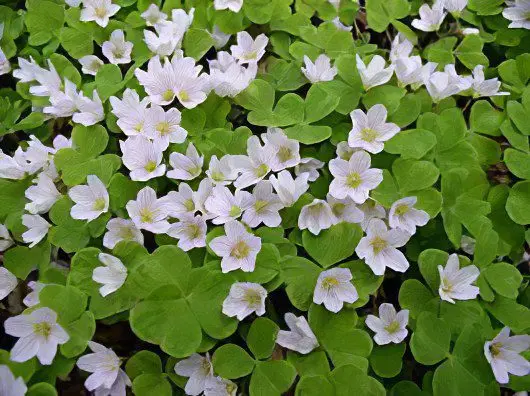Contents
Reproduction and application of the beneficial properties of sour
Botanical characteristics of oxalis

Oxalis belongs to perennial herbaceous plants of the Oxalis family. These plants reach a height of no more than 15 cm. Oxalis has a thin rhizome, branched and creeping in a horizontal direction. The basal leaves of the plant are located on fluffy and long petioles. Oxalis flowers are small, white with purple veins. In the summer, in addition to these flowers, practically on the ground, you can see small flowers located on short peduncles. Oxalis blooms in late spring – early summer. Seed ripening occurs in mid-summer. The fruit of the oxalis is an egg-shaped box, which itself throws out seeds.
Kislitsa is very common in Siberia, the Caucasus, the Non-Black Earth Region and the European part of the CIS. This plant prefers to grow on fertile moist soil, in alder, birch and coniferous forests, on ravines, on sandy and loamy soils.
Oxalis reproduction
Oxalis can be propagated by tubers that form near the tap root of already old plants. Separated tubers should be planted in pots in an amount of no more than 10 pieces per pot and covered lightly with earth. Seedlings should be planted depending on when it is necessary for the plant to bloom. From the moment of planting to the development of the plant will take about a month.
Oxalis can multiply with the help of leaves. To do this, cut the leaves with a small cutting and root them in a vessel with water. Plain wet sand can be used instead of water. As soon as the roots appear, you can immediately plant the cuttings in a pot.
Seeds can also be propagated. In this case, you need to sow the seeds on the ground and do not sprinkle them. The soil is moistened by spraying, in no case with a jet.
Acid care
For sour choose bright and lit places. However, the plant can also grow in partial shade, but not for long, because the plant will lose decorative leaves due to the constant shade. In a place with direct sunlight, the plant can get burned.
Oxalis does not need any special growing conditions. Summer is a time for abundant watering of the plant, but do not allow water to stagnate in pots with a plant. Oxalis does not tolerate excess moisture, so it is better to water less than more. Closer to autumn, oxalis should be watered less than in summer, but in winter, in general, you should just keep the soil moist.
The soil around the acid must be loosened and fertilized with mineral fertilizers. Fertilizers must be applied in the active growth stage every 20 days.
For acid, you need to prepare the soil by mixing soddy soil with leafy, humus and sand in equal proportions. Every year, young plants need to be transplanted, and older ones must be transplanted every two or even three years.
Useful properties of sour
All parts of the plant are used for medicinal purposes. Preparations from sour leaves have anti-inflammatory, diuretic and choleretic properties. Fresh acidic juice has an antitumor effect, helping to eliminate heavy metals from the body. In addition, acidic juice is recommended for people who have impaired metabolism and poor digestion. Crushed leaves help with purulent wounds.
Oxalis contains a lot of oxalic acid and other organic acids. Tinctures are prepared from the plant, which are used for various diseases of the stomach and liver. Oxide is an excellent antiseptic. Its juice cures scabies.
The use of acid

Oxalis is a plant that contains succinic acid, which is necessary for every person. Oxygen is used for various diseases of the bladder, as well as the gallbladder. Preparations from oxalis are used as a means of stopping bleeding. Oxide tincture helps heal wounds, cures jaundice and scurvy. Oxygen has antipyretic properties, so it is used for colds and flu.
Oxygen helps to cope with heartburn, reduces pain during menstruation, and also quenches thirst. Plant-based preparations relieve bad breath. Oxygen increases appetite, normalizes low acidity of the stomach.
A decoction of sour. To prepare it, take 1 teaspoon of dry acid grass, pour 100 ml of boiling water over it and put on fire for 12 minutes. After the broth has cooled, it is filtered and brought to the original volume with boiling water. This decoction is used for stomach cancer, 100 ml three times a day at the time of eating. In addition to internal use, this medicine is used as a mouth and throat rinse, washing abrasions and bruises.
Sour juice. Taking the aerial part of the plant, juice is squeezed out of it. It is taken for diarrhea and inflammatory diseases. It is necessary to take juice in 1 tablespoon, previously mixed with the same amount of honey. Such juice can be used for ulcerative stomatitis: in this case, it is diluted with water and rinsed with the oral cavity. Compresses are made from acidic juice for external use for diathesis, boils and abscesses.
Decoction at high temperature. Take 1 tablespoon of oxalis herb, pour 180 ml of hot milk into it and put it in a water bath for 30 minutes. Ready broth is taken half an hour before meals three times a day.
Contraindications to the use of sour
Oxalis contains a lot of oxalic acid, so it is impossible to use preparations from it for a long time, as this can lead to kidney damage. With arthritis, convulsions, urolithiasis and severe kidney diseases, acid is generally contraindicated. Before using oxalis, you need to consult a doctor who, if he allows you to use this plant as a medicine, will observe the reactions of the body.









